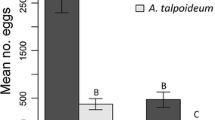Abstract
The triclads Polycelis tenuis and Dugesia polychroa and the glossiphoniid leeches Glossiphonia complanata and Helobdella stagnalis are abundant on the stony shores of productive British lakes. All species are food limited and there is considerable overlap in the diets of these triclads and leeches. This paper investigates interactions between the two groups using field and laboratory experiments to try to identify the mechanism of their co-existence. Triclad and leech numbers were manipulated inside experimental enclosures, mathced by controls, erected on the stony shore of an eutrophic English lake. Increasing the numbers of P. tenuis and D. polychroa prior to the reproductive season in spring resulted in a significant decrease in the numbers and body size of G. complanata and H. stagnalis compared with control populations in the summer months, and vice versa. However, increases and decreases were temporary with a readjustment of numbers and body size to control levels in the autumn after reproduction had ceased. It is suggested that increasing the numbers of either group elevated the severity of both intra- and interspecific competition for food. The “condition” of prey may, in part, determine the strength of competition, and this was examined in laboratory experiments in which different densities and ratios of P. tenuis and H. stagnalis were offered either live of recently crushed Asellus aquaticus. In monospecific controls, growth rates of P. tenuis were greater when fed on crushed than live Asellus, but there was no significant difference in the growth of H. stagnalis fed either live or crushed prey. In mixed cultures of predators, P. tenuis and H. stagnalis were the superior competitors when fed on crushed and live Asellus, respectively. However, when competitive pressure was low, at low densities of predators, the presence of H. stagnalis in mixed cultures fed on live prey was beneficial to the growth of P. tenuis. These results are explained in terms of the greater ability of triclads to detect damaged prey, leaking body fluids, due to their sophisticated chemosensory system, and the ability of leeches to capture live prey due to the presence of suckers. It is concluded that co-existence of the two groups in British lakes is assisted by the partitioning of food on a live or damaged basis.
Similar content being viewed by others
References
Law R, Watkinson AR (1987) Response-surface analysis of twospecies competition: an experiment on Phleum arenarium and Vulpia fasciculata. J Ecol 75:871–886
Martin AJ, Seaby RMH, Young JO (1994a) Food limitation in lake-dwelling leeches: field experiments. J Anim Ecol 63:93–100
Martin AJ, Seaby RMH, Young JO (1994b) The consequence of a food refuge collapse on a guild of lake-dwelling triclads and leeches. Hydrobiologia 277: 187–195
Martin AJ, Seaby RMH, Young JO (1994c) Does body size in the leeches Glossiphonia complanata and Helobdella stagnalis contribute to coexistence? Hydrobiologia 273:67–75
Reynolds CS (1979) The limnology of the cutrophic meres of the Shropshire-Cheshire plain. Field Stud 5:93–173
Reynoldson TB (1966) The distribution and abundance of lakedwelling triclads — towards a hypothesis. Adv Ecol Res 3:1–71
Reynoldson TB (1975) Food overlap of lake-dwelling triclads in the field. J Anim Ecol 44:245–250
Reynoldson TB (1983) The population biology of Turbellaria with special reference to the freshwater triclads of the British Isles. Adv Ecol Res 13:235–326
Reynoldson TB, Davies RW (1970) Food niche and co-existence in lake-dwelling triclads. J Anim Ecol 39:599–617
Reynoldson TB, Young JO (1963) The food of four species of lake-dwelling triclads. J Anim Ecol 32:175–191
Reynoldson TB, Young JO, Taylor MC (1965) The effect of temperature on the life-cycle of four species of lake-dwelling triclads. J Anim Ecol 34:23–43
Reynoldson TB, Gilliam JF, Jaques RM (1981) Competitive exclusion and co-existence in natural populations of Polycelis nigra and P. tenuis (Tricladida, Turbellaria). Arch Hydrobiol 92:71–113
Seaby RMH, Martin AJ, Young JO (1995) The reaction time of leech and triclad species to crushed prey and the significance of this for their co-existence in British lakes. Freshw Biol 43: 21–28
Spelling SM, Young JO (1987) Predation on lake-dwelling leeches (Annelida; Hirudinea): an evaluation by field experiment. J Anim Ecol 56:131–146
Young JO (1981) A comparative study of the food niches of lake-dwelling triclads and leeches. Dev Hydrobiol 6:91–102
Young JO, Ironmonger JW (1982a) A comparative study of the life histories of three species of leeches in two British lakes of different trophic status. Arch Hydrobiol 94:218–250
Young JO, Ironmonger JW (1982b) The influence of temperature on the life-cycle and occurrence of three species of lake-dwelling leeches (Annelida; Hirudinea). J Zool Lond 196:519–543
Young JO, Spelling SM (1989) Food utilization and niche overlap in three species of lake-dwelling leeches (Hirudinea). J Zool Lond 219:231–243
Young JO, Martin AJ, Seaby RMH (1993) Competitive interactions between the lake-dwelling leeches Glossiphina complanata and Helobdella stagnalis: an experimental investigation of the significance of a food refuge. Oecologia 93:156–161
Young JO, Seaby RMH, Martin AJ (1995) Contrasting mortality in young freshwater leeches and triclads. Oecologia 101: 317–323
Zar JH (1984) Biostatistical analysis. Prentice-Hall, New York
Author information
Authors and Affiliations
Rights and permissions
About this article
Cite this article
Seaby, R.M.H., Martin, A.J. & Young, J.O. Food partitioning by lake-dwelling triclads and glossiphoniid leeches: field and laboratory experiments. Oecologia 106, 544–550 (1996). https://doi.org/10.1007/BF00329714
Received:
Accepted:
Issue Date:
DOI: https://doi.org/10.1007/BF00329714




